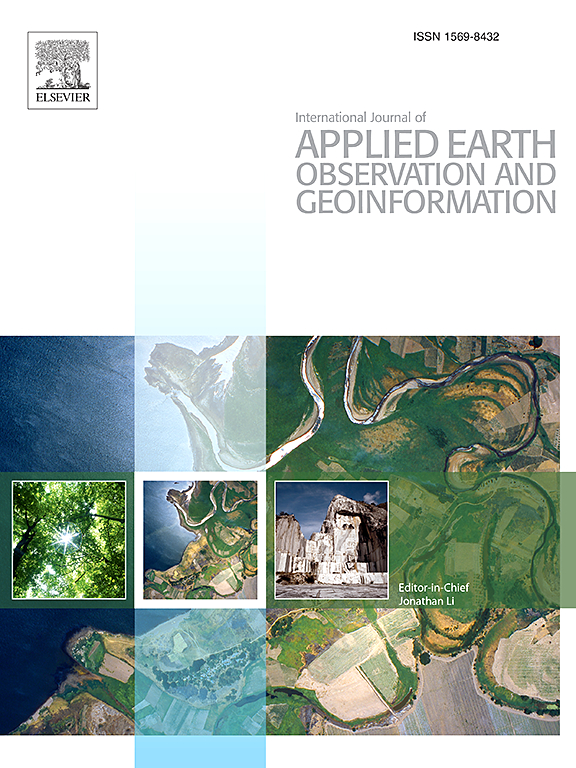HUTDNet: A joint unmixing and target detection network for underwater hyperspectral imagery
IF 7.6
Q1 REMOTE SENSING
International journal of applied earth observation and geoinformation : ITC journal
Pub Date : 2025-02-01
DOI:10.1016/j.jag.2025.104374
引用次数: 0
Abstract
Underwater hyperspectral target detection (HTD) technology holds pivotal value in enhancing maritime military power. However, the absorption and scattering properties of the water bodies result in the inevitable issue of mixed pixels in underwater hyperspectral images (HSIs). To address the issue, a joint hyperspectral unmixing and target detection network for underwater HSI is proposed, denoted as HUTDNet, which utilizes the material type and abundance information for downstream semantic tasks. Specifically, a nonlinear underwater unmixing network is designed to extract pure underwater endmembers and their associated abundance information, which is essential in assisting the subsequent target detection task. The network also extracts underwater virtual endmembers and their abundance values to reconstruct a more realistic underwater HSI. Then, the abundance weighting module determines the abundance weighting factor by calculating the spectral distance between a priori target spectra and the estimated underwater pure endmembers, generating a weighted abundance map. Finally, due to the inherent limitations in the characterization capabilities of abundance maps and endmembers, the detection network extracts key spectral feature maps from the input underwater HSI. These feature maps serve as complementary terms, fused with the original and weighted abundance maps. Subsequently, convolutional and fully connected layers are employed to extract deeper features and generate the target detection maps. Experiments on both real and synthetic datasets demonstrate the superior performance and efficiency of the proposed method in this paper compared to other state-of-the-art methods.
HUTDNet:一种水下高光谱图像解混与目标检测联合网络
水下高光谱目标探测技术在增强海上军事力量中具有举足轻重的价值。然而,水体的吸收和散射特性导致了水下高光谱图像中不可避免的混合像元问题。为了解决这一问题,提出了一种水下高光谱解混和目标检测联合网络,称为HUTDNet,该网络利用材料类型和丰度信息进行下游语义任务。具体而言,设计了一个非线性水下解混网络来提取纯水下端元及其相关丰度信息,这对后续的目标探测任务至关重要。该网络还提取了水下虚拟端元及其丰度值,以重建更真实的水下HSI。然后,丰度加权模块通过计算先验目标光谱与估计的水下纯端元之间的光谱距离来确定丰度加权因子,生成加权丰度图。最后,由于丰度图和端元表征能力的固有局限性,检测网络从输入的水下HSI中提取关键光谱特征图。这些特征图作为补充术语,与原始的和加权的丰度图融合在一起。随后,使用卷积和全连接层提取更深的特征并生成目标检测图。在真实数据集和合成数据集上的实验表明,与其他最新方法相比,本文提出的方法具有优越的性能和效率。
本文章由计算机程序翻译,如有差异,请以英文原文为准。
求助全文
约1分钟内获得全文
求助全文
来源期刊

International journal of applied earth observation and geoinformation : ITC journal
Global and Planetary Change, Management, Monitoring, Policy and Law, Earth-Surface Processes, Computers in Earth Sciences
CiteScore
12.00
自引率
0.00%
发文量
0
审稿时长
77 days
期刊介绍:
The International Journal of Applied Earth Observation and Geoinformation publishes original papers that utilize earth observation data for natural resource and environmental inventory and management. These data primarily originate from remote sensing platforms, including satellites and aircraft, supplemented by surface and subsurface measurements. Addressing natural resources such as forests, agricultural land, soils, and water, as well as environmental concerns like biodiversity, land degradation, and hazards, the journal explores conceptual and data-driven approaches. It covers geoinformation themes like capturing, databasing, visualization, interpretation, data quality, and spatial uncertainty.
 求助内容:
求助内容: 应助结果提醒方式:
应助结果提醒方式:


